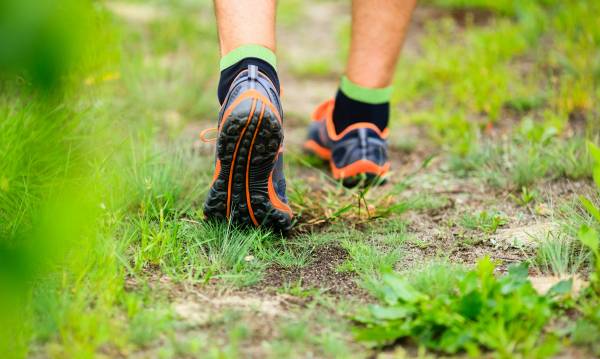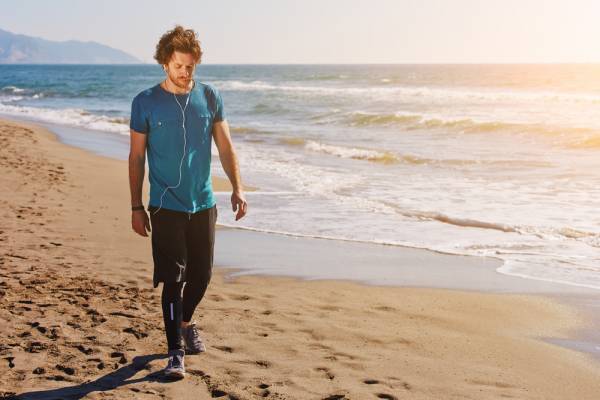Want to feel better, look sexier, and live longer? Walk more. As health advice goes, it’s not exactly earth shattering. But it’s often ignored.
As a species, walking is what we do best. In fact, it’s probably how your ancestors got from Africa to where they eventually settled.1 The standardized movement guidelines of thirty minutes per day are based on the dramatic benefits that walking can have on your health, yet nobody seems to do it.18 For the average time-poor person, the fundamental movement pattern of walking is frequently shunned in favor of more intense forms of exercise. However, the beneficial effects of walking on health are multiple and far-reaching.
This is the second of my articles detailing why The Great Upside-Down Movement Pyramid can be your one-stop framework for lifelong health. In this piece, I’ll cover why now that you’re sitting less, you should start walking more.
Calming the Fires
Modern-day living doesn’t seem to be geared towards providing optimal health. The combination of the daily grind, the food we eat, and our need to stay in one place to work all day have all been linked to increased inflammation, and through that, the rising rates of cancer, type 2 diabetes, heart disease, and obesity.5–8 Sadly, we can’t all change our jobs and live off the land. Instead of resorting to pills and antioxidant concoctions that may undo some of your good work, starting to move more by increasing walking is the best step towards reversing some of those issues.9,10
“Aerobic exercise, such as brisk walking, also increases your ability to handle oxidative damage.This makes movement both an anti-inflammatory, and an antioxidant.”
When we move our muscles, signaling molecules (often referred to as myokines) are released. Though many of these myokines can also be associated with an inflammatory response, when stimulated by exercise, they actually decrease inflammation.11 This is one of the main reasons why regular walking can dramatically reduce the risk of metabolic diseases, as well as certain cancers, and even erectile dysfunction.13–17 Aerobic exercise, such as brisk walking, also increases your ability to handle oxidative damage.12 This makes movement both an anti-inflammatory, and an antioxidant. And all without a single pill in sight.
Losers Walk
Though many people still rely on counting calories as their guide to fat loss, there isn’t as much evidence to support this idea as we’re led to believe. Not all calories are created equal, and simply inducing a calorie deficit by increasing exercise alone does not induce long-term weight loss.2,3 Fear not, though. The upside of this complex equation is that some activities that don’t “burn” many calories can still help with weight management (if you’re into that kind of thing). Instead of worrying about starving yourself thin, you can produce significant fat loss by spending less time sitting and more time walking.4 No gym membership or Weight Watchers* required.
*Other starvation programs with minimal scientific backing are also available.
Every Little Helps
As I’ve previously mentioned, killing yourself on the treadmill isn’t enough to compensate for the negative effects that a sedentary lifestyle can have on your life expectancy. This means that movement needs to be built into your day, and the best way to do this is to walk more. For most of us, this can begin with walking to work.19 Use public transport? Get off a stop or two earlier. Drive to work? Use a park and ride, and walk the last ten to twenty minutes. Worried about being late for work? Perfect – a brisk pace is associated with even greater benefits.20

To build on this, there are a number of other ways to add walking into your day:
- Break it up: Walk while you take a phone call at work, or pop out for few minutes between meetings. Accumulating walking time in segments of just two or three minutes is enough to improve metabolism.21,22
- Lunch with friends: Even the shortest lunch break is enough time to get some walking done. And why not drag your co-workers with you, for a more relaxed and more productive workplace?24,25
- Move around meals: Evening meal times are another great opportunity to walk. Do a quick lap while dinner finishes in the oven. Even better, take a stroll after you’ve finished eating.22,26 Your online dating profile says you like long romantic walks in the sunset, but when was the last time you actually took one?
Most importantly, all this walking adds up. Multiple ten-minute walks may even be better than one long one.23,29 This means that ten minutes to/from work, ten minutes at lunch, and ten minutes after dinner is a fantastic start.
Pro Tips
If you’re the kind of person whoneeds a firm plan before going walking, you might have two questions left – where should I walk, and how fast should I walk?
- Take it outside: Most of the studies examining the effects of walking on health use a treadmill in a sports science laboratory, or give people pedometers to track their steps without specifically examining where they’re doing the walking. This suggests that you can walk pretty much anywhere to see most of the health improvements. However, studies have found greater psychological benefits of walking outdoors in green areas compared to walking indoors or in the city.30 Most importantly, finding the environment that you enjoy the most, be it the beach, a river, forest, or park, is likely to give you the greatest benefit of all.31
- Outpace death: I know what you’ve been wondering all along. How fast do you have to move to beat the grim reaper? Luckily, science has the answer, and it appears to be three miles per hour.27 Other studies suggest that eighty percent of your maximal walking speed is the most efficient and sustainable pace.28 If you want to estimate these speeds, try one of the following:
- Use a map or online pedometer to measure a nearby half-mile loop. Aim to complete it in ten minutes (three miles per hour).
- Find a short stretch where you can walk as quickly as possible for twenty seconds. For a speed that is eighty percent of maximum, cover the same distance in 25 seconds.
Bear in mind that the key is to get moving and build habits rather than hit a specific speed. Take the time to walk, and enjoy it. As we all know, faster isn’t always better.

Summary
Skipped to the end? Here’s what you need to know:
- After sitting less, start walking more
- Accumulate at least thirty minutes per day
- Aim for eighty percent of your maximum walking speed, or at least three miles per hour. Alternatively, just walk as if you’re late for work.
- For maximal benefits, find your favorite local outdoor spot, and take some friends with you.
More Like This:
- A Simple System for Staying Healthy and Active to the Very End
- Move Slowly if You Must, but Move
- Walking: The Most Underrated Movement of the 21st Century
- New on Pulse Beat Fit Today
References:
1. Klein. “Out of Africa and the evolution of human behavior.” Evol. Anthropol. 2008 17: 267–281.
2. Feinman and Fine. “Nonequilibrium thermodynamics and energy efficiency in weight loss diets.” Theor Biol Med Model. 2007 Jul 30;4:27.
3. Franz et al. “Weight-loss outcomes: a systematic review and meta-analysis of weight-loss clinical trials with a minimum 1-year follow-up. J Am Diet Assoc. 2007 Oct;107(10):1755-67.
4.Healy et al. “Replacing sitting time with standing or stepping: associations with cardio-metabolic risk biomarkers.” Eur Heart J. 2015 Jul 30. [Epub ahead of print]
5.Emeny et al. “Job strain-associated inflammatory burden and long-term risk of coronary events: findings from the MONICA/KORA Augsburg case-cohort study.” Psychosom Med. 2013 Apr;75(3):317-25.
6. Bosma-den Boer et al.. “Chronic inflammatory diseases are stimulated by current lifestyle: how diet, stress levels and medication prevent our body from recovering.” Nutr Metab (Lond). 2012 Apr 17;9(1):32.
7. Mathews et al.. “How do high glycemic load diets influence coronary heart disease?” Nutr Metab (Lond). 2015 Mar 8;12:6.
8. Tommy Wood, Move It Or Lose It: How to Sit Less, Move More, and Feel Better, Pulse Beat Fit UK, 2015.
9. Ristow et al.. “Antioxidants prevent health-promoting effects of physical exercise in humans.” Proc Natl Acad Sci U S A. 2009 May 26;106(21):8665-70.
10. Craig Marker, Do Antioxidants Impede the Benefits of Exercise? Pulse Beat Fit, 2015.
11. Pedersen. “The anti-inflammatory effect of exercise: its role in diabetes and cardiovascular disease control.” Essays Biochem. 2006;42:105-17.
12. Gomez-Cabrera et al.. “Moderate exercise is an antioxidant: upregulation of antioxidant genes by training.” Free Radic Biol Med. 2008 Jan 15;44(2):126-31.
13.Roussel et al.. Influence of a walking program on the metabolic risk profile of obese postmenopausal women. Menopause. 2009 May-Jun;16(3):566-75.
14. Buman et al.. Reallocating time to sleep, sedentary behaviors, or active behaviors: associations with cardiovascular disease risk biomarkers, NHANES 2005-2006. Am J Epidemiol. 2014 Feb 1;179(3):323-34.
15. Wolin et al.. Physical activity and colon cancer prevention: a meta-analysis. Br J Cancer. 2009 Feb 24;100(4):611-6.
16. Hildebrand et al.. “Recreational physical activity and leisure-time sitting in relation to postmenopausal breast cancer risk.” Cancer Epidemiol Biomarkers Prev. 2013 Oct;22(10):1906-12.
17. Bacon et al.. “Sexual function in men older than 50 years of age: results from the health professionals follow-up study.” Ann Intern Med. 2003 Aug 5;139(3):161-8.
18. Boone-Heinonen et al.. “Walking for prevention of cardiovascular disease in men and women: a systematic review of observational studies.” Obes Rev. 2009 Mar;10(2):204-17.
19. Laverty et al.. “Active travel to work and cardiovascular risk factors in the United Kingdom.” Am J Prev Med. 2013 Sep;45(3):282-8.
20. Hu et al.. “Walking compared with vigorous physical activity and risk of type 2 diabetes in women: a prospective study.” JAMA. 1999 Oct 20;282(15):1433-9.
21. Latouche et al.. “Effects of breaking up prolonged sitting on skeletal muscle gene expression.” J Appl Physiol (1985). 2013 Feb 15;114(4):453-60.
22. Miyashita et al.. “Accumulating short bouts of brisk walking reduces postprandial plasma triacylglycerol concentrations and resting blood pressure in healthy young men.” Am J Clin Nutr. 2008 Nov;88(5):1225-31.
23. Park et al.. “Accumulation of physical activity leads to a greater blood pressure reduction than a single continuous session, in prehypertension.” J Hypertens. 2006 Sep;24(9):1761-70.
24. Puig-Ribera et al.. “Self-reported sitting time and physical activity: interactive associations with mental well-being and productivity in office employees.” BMC Public Health. 2015 Jan 31;15:72.
25. Thøgersen-Ntoumani et al.. “Changes in work affect in response to lunchtime walking in previously physically inactive employees: A randomized trial.” Scand J Med Sci Sports. 2015 Jan 6. [Epub ahead of print]
26. Manohar et al.. The effect of walking on postprandial glycemic excursion in patients with type 1 diabetes and healthy people. Diabetes Care. 2012 Dec;35(12):2493-9.
27. Stanaway et al.. “How fast does the Grim Reaper walk? Receiver operating characteristics curve analysis in healthy men aged 70 and over.” BMJ. 2011 Dec 15;343:d7679.
28. Schwarz et al.. “Cardiocirculatory and metabolic responses at different walking intensities.” Br J Sports Med. 2006 Jan;40(1):64-7.
29. Holmstrup et al.. “Multiple short bouts of exercise over 12-h period reduce glucose excursions more than an energy-matched single bout of exercise.” Metabolism. 2014 Apr;63(4):510-9.
30. Marselle et al.. “Walking for well-being: are group walks in certain types of natural environments better for well-being than group walks in urban environments?” Int J Environ Res Public Health. 2013 Oct 29;10(11):5603-28.
31. Marselle et al.. “Moving beyond green: exploring the relationship of environment type and indicators of perceived environmental quality on emotional well-being following group walks.” Int J Environ Res Public Health. 2014 Dec 23;12(1):106-30.
Photos courtesy of Shutterstock.






